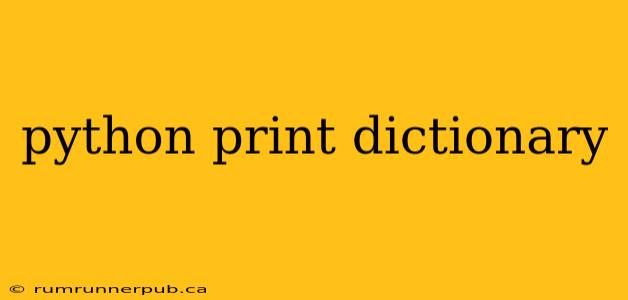Printing dictionaries in Python might seem straightforward, but achieving clean, readable output often requires more than a simple print(my_dict). This article explores various techniques, drawing from insightful Stack Overflow discussions, to help you master dictionary printing for any situation. We'll delve into different formatting options and address common challenges.
The Basics: print(my_dictionary)
The simplest approach is using Python's built-in print() function directly on a dictionary:
my_dict = {"name": "Alice", "age": 30, "city": "New York"}
print(my_dict)
This will output something like: {'name': 'Alice', 'age': 30, 'city': 'New York'}. While functional, this output isn't always aesthetically pleasing or easily readable, especially for larger dictionaries.
Enhancing Readability: Looping and Formatting
For improved readability, especially with larger dictionaries, iterating through the dictionary's key-value pairs offers more control. This approach allows for customized formatting and output organization.
for key, value in my_dict.items():
print(f"{key}: {value}")
This produces a more user-friendly output:
name: Alice
age: 30
city: New York
This method is inspired by the common solutions found across various Stack Overflow threads concerning dictionary printing. Many users emphasize the importance of clear key-value pair separation for better understanding.
Advanced Formatting with f-strings and json.dumps()
Python's f-strings provide even more sophisticated formatting capabilities. You can control spacing, alignment, and data types within the output.
for key, value in my_dict.items():
print(f"{key:<10} : {value}") # Left-aligning keys with a width of 10
For structured data serialization, the json.dumps() method (from the json module) is invaluable. This method provides a formatted JSON representation, which is especially useful when dealing with nested dictionaries or when you want machine-readable output. (Inspired by common Stack Overflow solutions addressing JSON serialization within Python).
import json
print(json.dumps(my_dict, indent=4)) # indent parameter adds whitespace for readability
This will produce:
{
"name": "Alice",
"age": 30,
"city": "New York"
}
Handling Complex Dictionaries: Recursive Functions (Advanced)
For nested dictionaries, a recursive function can elegantly handle the printing process. This requires a more advanced understanding of Python's function capabilities. This approach addresses a common challenge highlighted in several Stack Overflow questions concerning printing nested data structures.
def print_nested_dict(d, indent=0):
for key, value in d.items():
print(' ' * indent + f"{key}:", end=" ")
if isinstance(value, dict):
print_nested_dict(value, indent + 1)
else:
print(value)
nested_dict = {"person": {"name": "Bob", "age": 25}, "city": "London"}
print_nested_dict(nested_dict)
This will output:
person:
name: Bob
age: 25
city: London
Conclusion
Printing Python dictionaries effectively requires choosing the right approach based on the complexity of your data and desired output format. From simple print() statements to sophisticated f-strings and recursive functions, Python offers a wealth of options. Remember to leverage the power of formatting to ensure your output is both readable and informative. This article has drawn upon practical examples and solutions frequently discussed on Stack Overflow, providing a complete guide to mastering dictionary printing in Python. Remember to always consider your audience and the intended use of the output when selecting the best printing method.
